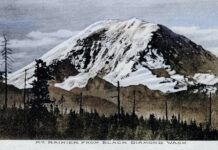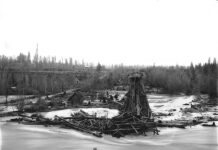Frank Grens had a face to charmed photographers. It was the kind of face that told tales of long-ago lumberjacks, coal miners, mule drivers, and bridge builders. A face that everybody knew, yet few knew much about. Many called him “Miner Frank.”
In later years, Frank Grens lived a reclusive life in a windowless, 560-square-foot structure perched on a bank, 100 feet above the rushing waters of the Green River. The building was formerly a wash house where coal miners changed into work clothes then showered at the end of each shift. The simple structure served workers at Franklin No. 10, who crossed the river each day on a rickety bridge that accessed the mine portal on the east side. It was the last coal mine in the Green River Gorge closing in March 1971. Before occupying the wash house, Grens lived in his camper nearby.
Many hikers and adventures came to know Frank Grens. He served as a watchman for Palmer Coking Coal Company in the last dozen years of his life. Before his coal mining days, Frank labored as a lumberjack, clay miner, and construction worker. Later, he drove mules in Black Diamond’s Lawson Mine. Grens married Ruth Loscar in August 1939 and a baby girl, Diane Carol Grens was born one month later. Two sons, Frank S. Grens and Stanley Juan Grens followed in 1949 and 1958. Frank’s marriage was tempestuous, and three times Ruth filed for divorce, but it’s unclear if the breakup was ever finalized.
Frank Grens was born in 1911 in the anthracite region of Scranton, Pennsylvania, and moved to the soft-coal pits of Southern Illinois as a toddler. His parents, August Grens and Maria Louisa Frets were Polish immigrants to America. At age 17, Frank hopped a train heading west and hopped off when it stopped in the foothills of the Cascades. There a brother, Albert Grens worded as a timber hoister for a Black Diamond coal mine. By 1930, Frank was living with Morton and Anna Mann and later found employment on the Kummer Bridge crew during its construction in 1932-33.
The day before Pearl Harbor, December 6, 1941, a roof beam in a mine tunnel collapsed on Frank’s back, pinning him to the ground. He overcame the injury and later joined Palmer Coking Coal where he worked on and off through the years. Another brother, Stanley Grens died while fighting for the Army in December 1944 in Luxembourg, where he is buried. Frank had run-ins with the law in May 1945 and spent some time in jail. However, by 1950, Frank, Ruth, and the two children were living in Enumclaw where Frank labored in and out of the mining industry.
Eventually, Frank drifted away from his family and began living the life of a vagabond. His world was centered on hunting and fishing. Like the hoboes of his day, Frank hitched rides on trains and foraged for food in the great outdoors. He bragged about not spending a dime along the way. One of his specialties was canning fish eggs that he used for bait when fishing.
The exterior of his wash house cabin was decorated with deer antlers next to a sign that announced you were at the residence of a “VIP, Mayor of Franklin and Dog Catcher.” A nearby sign warned, “Trespassing may be dangerous to you hide and long hair. Keep out!” Inside hung fishing nets placed next to the pinups of Playboy centerfolds that lined the walls. A mahogany-stained crutch stood as testimony to the years he worked around mines. Beyond the shack was a small garden he tended.
In time, word of Frank’s Spartan lifestyle reached civilization, and newspaper reporters made a pilgrimage to interview the last resident of Franklin, a coal mining town established in 1883 by the Oregon Improvement Company. Lou Corsaletti ran a feature story about Frank in the May 5, 1977, Seattle Times. A couple of years later, Grens suffered a stroke, which left him unable to speak. With hand gestures delivered with a stream of curses, cuss words, and stuttered syllables, Frank communicated as best he could, all the time showcasing his toothless smile.
Many fondly remembered Grens, including Patti Chapman-Courtright, who provided tidbits about his life for this column. Patti’s father, Bill Chapman, was the mine electrician who, like many, periodically checked in on Frank, listened to his stories, and typically went home with jars of his homemade relish, jams, and fish eggs.
On September 23, 1983, Grens was photographed by Mark Morris and Nathalie Overland from the Valley Daily News, which published newspapers in Auburn, Kent, and Renton. Their photo was submitted to a documentary project sponsored by the National Press Photographers Association called “A Day in the Life of Washington.” This photo by the Valley Daily News comes courtesy of the Black Diamond Historical Museum. It appeared in that newspaper with a eulogy remembrance a few days after Frank Grens death from a heart attack on Thanksgiving Day, 1983. Genealogical information for this story was supplied by Donna Brathovde, a Ravensdale historian and research specialist.







